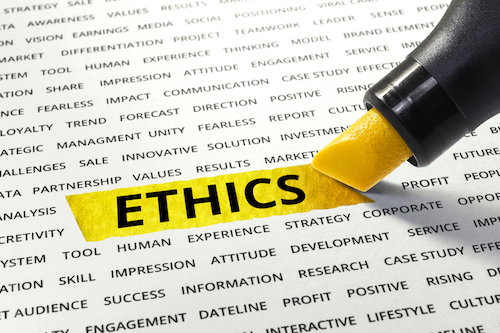In its recently released report, the Commission on Public Relations Education recommended adding a course in ethics to the core PR curriculum. According to the Commission, ethics is “more essential than ever in our current age of disinformation, alternative facts and ‘fake news.’”
Of course, ethics has always been essential to professional success in public relations — just as ethics is essential to successful practice in all professions. Nonetheless, as one who has been teaching, writing and speaking about ethics in public relations for more than 20 years — and as a former member of the task force that developed the 2000 PRSA Code of Ethics — I was heartened to see the Commission’s increased focus on ethics.
A critical first step in advancing ethics in practice is making ethics relevant to professional success. And making ethics part of the core PR curriculum highlights the importance of ethics in career preparation and advancement. Indeed, adding ethics to one’s professional portfolio could be the distinguishing characteristic that results in a job offer or promotion. Research by the Commission found that practitioners ranked only writing and communication higher than ethics in importance to the success of entry-level practitioners.
Developing ethical competencies
The drafters of the 2000 PRSA Code of Ethics recognized that ethics education, along with some inspiration, would be key to helping PRSA members make ethics a priority in professional practice. Given the challenges associated with enforcing a voluntary code of ethics, the group focused on defining ethical obligations affirmatively (rather than punitively), offering clear and concise core values and principles, and encouraging continuing ethics education.
Ethics training comes in many shapes and sizes, ranging from a quick review of industry and organization codes during a coffee break or a session on ethics at a professional conference to an ethics webinar online or a review of a new ethics book at the beach. All these types of training can help develop ethical competencies by providing time to contemplate ethical dilemmas and consider proper responses before practitioners are in situations that require thoughtful and quick responses with little time for reflection.
Building an ethics portfolio
There are four key aspects to building a professional ethics portfolio. First is raising one’s ethical consciousness in order to recognize the ethical dimensions of a client’s or employer’s decisions and actions. Second is becoming familiar with the professional and organizational standards, principles and values that should guide ethical conduct. Third is crafting and/or adopting an ethical decision-making process that can be applied in practice to ensure ethical outcomes. Fourth is enhancing one’s ability to justify decisions and counsel on the basis of sound reasoning and best practices.
Another important aspect of enhancing ethics capabilities — especially for new pros — is developing the professional courage to raise your hand in times of ethical conflict, or as one of my students put it, being able to say “no” to the boss. Having a plan for speaking up when ethical standards are being violated arms you with the tools and expertise — and confidence — needed to provide sound and effective counsel that helps resolve conflicts and issues in ways that ethically advance a client’s or employer’s goals.
Making ethical decisions
A number of ethical decision-making guides have been offered by PR scholars and professionals to aid practitioners in evaluating and resolving ethical dilemmas. Most involve articulating ethical issues, such as defining the core values and principles that should guide decision making, identifying parties that will be affected by a decision or action, balancing conflicting loyalties and obligations, anticipating outcomes and considering alternative solutions.
Whatever guide is followed, the process should ensure that the interests of all parties affected by organizational decisions and actions are considered and respected — and core values and principles upheld. The bottom line for PR professionals operating in a democratic marketplace of ideas in which truth and transparency are imperative for effective governance is to be sure that our work contributes to — rather than interferes with — informed decision-making.
Although not always an easy path — especially when a client or employer wants to go in a different direction — saying “no” instead of “yes” ultimately may be the route to promotion and professional success. As the PRSA Code of Ethics states: “Each of us sets an example for each other — as well as other professionals — by our pursuit of excellence with powerful standards of performance, professionalism and ethical conduct.”
Kathy Fitzpatrick, J.D., APR, is a professor in the School of Communication at American University, and a senior adviser to organizations on matters related to public relations, public diplomacy and strategic communication.








Kathy was the backbone of the ethics code redesign team during the three years it took to complete the task.
Among her singular contributions was the Fitzpatrick Ethics Problem Analysis Model. See it on PRSA.org under ethiccs.
It is a simple, sensible and powerful tool for prompt Ethics problem analysis.
Kathy and Jim, what was the previous code of ethics, pre-2000? I’m sure I have it buried in a box somewhere, but I’d love to hear what changes your team made in creating the new one?
Saying no to the boss can be a professionally toxic strategy.
It’s like saying no to a four-year-old. They are offended by it, it encourages them to do it anyway, and always remember you in a bad light because of it. There are alternatives.
Decades of observation in the field and informal surveying of senior practitioners demonstrates three surprising things about giving bosses crucial negative advice:
1. The majority of PR practitioners, although they might truly want to, never expect to give advice directly to the boss, are very uncertain should the opportunity arise, and they would prefer not to do it.
2. Senior practitioners have little confidence in their personal ability to affect boss decision-making, and don’t want to take the risk.
3. The majority of PR practitioners responding to questionnaires feel ill-equipped to give useful advice to operating people more senior than themselves, in crucial areas like operations, ethics, morals and the operating aspects of crisis situations.
Modern PR education has yet to learn to teach PR practitioners the art of influencing important individuals much beyond concerns involving the media and communications. These are area, ironically, in which virtually all leaders and managers consider themselves to be quite competent, often even excellent. So, when given advice of any kind from a communicator, rather than listening and learning, managers and leaders, those who actually operate an organization, mentally debate the value of what they are hearing and generally reject it for their own ideas.
The art of influencing leaders especially in troubled times when the bosses are hunkering down, feeling an acting defensively is a very poor time to say no, about anything. To have influence, in short, is to always provide a range of calm, simple, sensible, useful, doable, positive, constructive and helpful options from which operators can choose for themselves. Leave no off the list because PR practitioners or staff function have little credibility to make the case for no from an operating perspective.
My experience , including catastrophic and humiliating failures teaches me that for every decision where we propose action by someone in operations that the recommendations come in the form of three options, with proof points:
1. Doing nothing which has a 50/50 chance of acceptance (the 0% option)
2. Doing something (the 100% option)
3. Doing something more (the 125% option)
Then, allowing operators the opportunity to choose, rather than take orders from staff people. This is, after all, why leaders become leaders. They want to take responsibility for the decisions that move the organization forward. Telling them no is usurping the very rationale these people have for assuming the risks of leadership. Plus, when told no by anyone, except their mothers perhaps, leaders are like four year old’s. Tell them not to put their finger in the electrical outlet assures that they will at least try when you’re not looking.
You have better options, choices that make leaders better and at the same time help them to take appropriate responsibility for their actions and decisions from the start.
This was a wonderful read in perfect timing of ethics month. It is so important to remember that we are all responsible and held to the same standard when it comes to ethics. However, when we are put into a situation when ethics is not the priority we need to be confident and aware so that we can react accordingly. -Ali Carden, writer/editor for Platform Magazine